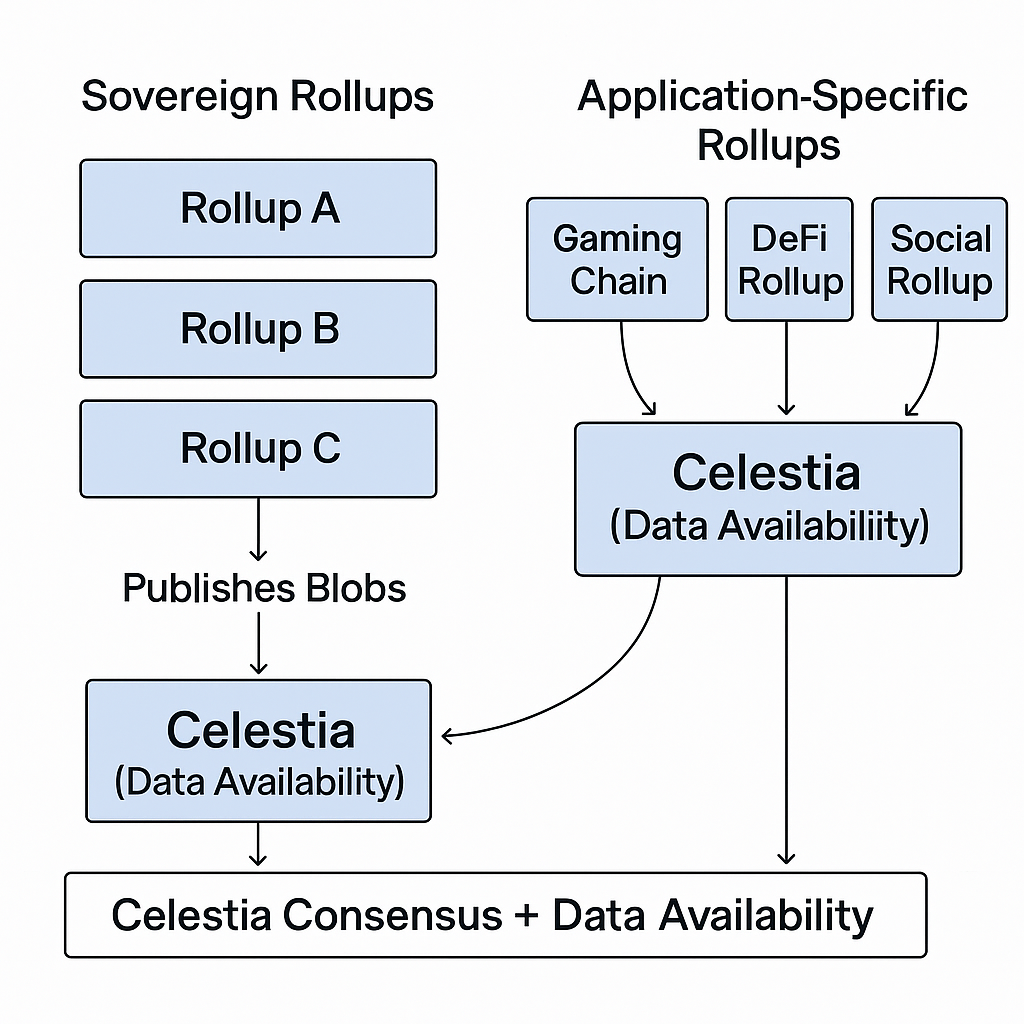Ecosystem and Use Cases
This module examines how Celestia’s modular architecture is applied in practice. It discusses sovereign rollups and application-specific chains, explaining how projects can innovate independently while relying on Celestia for data availability. Real-world examples such as Dymension, Eclipse, and Manta Pacific are explored, alongside experimental work on integrating Bitcoin. The section emphasizes the importance of ecosystem diversity and modular scalability.
The Emergence of Sovereign Rollups

One of the most important developments within the Celestia ecosystem is the rise of sovereign rollups. Unlike smart contracts deployed on existing blockchains, sovereign rollups operate as independent blockchains that rely solely on Celestia for consensus and data availability.
This means they do not depend on another settlement layer such as Ethereum to arbitrate disputes or validate execution. Instead, they publish their data as blobs on Celestia and handle execution and governance on their own terms. This design gives projects full control over their rules, upgrades, and governance structures while still benefiting from Celestia’s scalability and data availability guarantees.
Sovereign rollups highlight the flexibility of Celestia’s modular architecture. By removing reliance on a settlement chain, they allow developers to create purpose-built blockchains tailored to specific applications, whether financial systems, social platforms, or gaming environments. The role of Celestia here is foundational but limited: it guarantees that the data is published and available, while the sovereign rollup retains autonomy over its own ecosystem.
Application-Specific Chains
Within the broader Celestia ecosystem, many teams are pursuing application-specific chains. These are blockchains designed with a narrow focus rather than general-purpose programmability. Application-specific rollups benefit from Celestia because they do not need to expend resources on building their own consensus mechanism. Instead, they can publish their data to Celestia and concentrate on optimizing execution for their chosen use case.
For example, a decentralized exchange could launch as a sovereign rollup, posting trade data to Celestia while implementing highly optimized execution logic for matching orders. Similarly, a gaming project could build a rollup that processes in-game transactions at high throughput without competing for blockspace with unrelated applications. By enabling this model, Celestia allows projects to avoid the inefficiencies of shared execution environments and instead tailor their chains to the demands of their users.
The Role of Rollkit in the Ecosystem
Rollkit has become the framework of choice for many projects building sovereign rollups. Its ability to integrate directly with Celestia and handle blob submission reduces the complexity of launching new chains. Developers can define execution environments using the Cosmos SDK, the Ethereum Virtual Machine, or other virtual machines, and then use Rollkit to manage block production and posting to Celestia. This makes it possible for projects to focus on innovation rather than infrastructure, accelerating experimentation across the ecosystem.
The neutrality of Rollkit also fosters diversity. Because it does not impose a single execution model, projects ranging from DeFi protocols to non-financial applications can use it to build sovereign rollups. This has created a dynamic ecosystem where multiple execution environments coexist, all secured by Celestia’s data availability guarantees.
Examples of Projects Leveraging Celestia
Several projects already illustrate how Celestia and Rollkit are being used in practice. Dymension has positioned itself as a network of rollups, referred to as RollApps, that each connect to Celestia for data availability while sharing liquidity and infrastructure at a higher layer. Eclipse is building a framework that allows developers to deploy rollups with different execution environments, including the Solana VM and the Ethereum VM, while outsourcing data availability to Celestia. Manta Pacific has adopted Celestia to reduce costs for its zkEVM rollup, using Blobstream to post data efficiently while maintaining the security guarantees of zero-knowledge proofs.
These examples show that Celestia is not tied to a single category of projects. Instead, it supports a wide spectrum of use cases, from highly experimental DeFi applications to institutional-grade rollups seeking to optimize transaction costs. The unifying element across these projects is their reliance on Celestia’s data availability layer, which provides the infrastructure they need to operate securely and at scale.
Experimental Integrations with Bitcoin
Beyond the projects already live, there is growing interest in integrating Celestia’s modular concepts with Bitcoin. Research prototypes have demonstrated that Rollkit can be used to build rollups that rely on Bitcoin as their data availability layer. This is an experimental idea but one with significant implications. If Bitcoin data can be combined with rollup execution through a framework like Rollkit, it would open new possibilities for building scalable applications on top of the world’s most secure blockchain.
The Bitcoin integration highlights the adaptability of the modular design. It shows that Celestia’s approach is not limited to its own ecosystem but could inspire broader innovation across the blockchain space. Even if these experiments remain in early stages, they point to the potential for modular blockchains to interact with and enhance existing networks.
Why the Ecosystem Matters
The projects emerging around Celestia demonstrate that modular blockchains are not only a theoretical concept but a practical path forward for scaling decentralized systems. By allowing developers to launch sovereign rollups and application-specific chains, Celestia is reducing barriers to entry and creating space for innovation. Rollkit provides the tooling necessary to make these projects feasible, while Blobstream ensures that their data availability guarantees remain strong.
The ecosystem also illustrates the broader implications of modularity. Instead of competing for scarce blockspace on monolithic chains, applications can operate independently while still sharing the security of a common data availability layer. This reduces congestion, lowers costs, and creates an environment where specialized blockchains can thrive alongside one another. In doing so, Celestia and its ecosystem of projects are redefining how scalability, sovereignty, and interoperability are approached in blockchain design.





